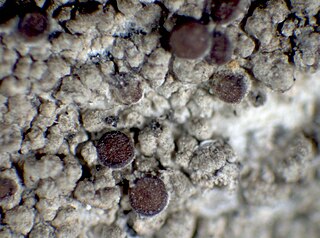
Collema is a genus of lichens in the family Collemataceae. The photobiont is the cyanobacterium genus Nostoc. Species in this genus typically grow on nutrient-rich bark or somewhat siliceous or calcareous rocks in humid environments.

The Arthoniaceae are a family of lichenized, lichenicolous and saprobic fungi in the order Arthoniales. The Arthoniaceae is the largest family of Arthoniales, with around 800 species. Most species in Arthoniaceae belong in Arthonia which is the largest genus with 500 species. The second and third largest genus is Arthothelium with 80 species, and Cryptothecia with 60 species.

The Pannariaceae are a family of lichens in the order Peltigerales. Species from this family have a widespread distribution, but are especially prevalent in southern temperate regions.

Ochrolechia is a genus of crustose lichens in the family Ochrolechiaceae. These lichens typically form uneven, often thick, crust-like growths on various surfaces and are characterised by their white to pale grey thalli, which may have a greenish tint. The genus has a long evolutionary history, with fossils dating back to the Paleogene period, about 34 million years ago. Ochrolechia species have disc-like apothecia, which are usually yellowish or brownish-pink and often covered with a fine white powdery coating. The genus is widely distributed and includes both common and rare species, with some found in extreme environments such as arctic and alpine regions. Ochrolechia lichens produce diverse secondary metabolites, including orcinol depsides, depsidones, and xanthones.

Psoroma is a genus of lichen-forming fungi in the family Pannariaceae. The widespread genus contains about 30 species, most of which are found in south temperate regions.

Diploschistes is a genus of lichen-forming fungi in the family Graphidaceae. Commonly known as crater lichens, members of the genus are crustose lichens with a thick, cracked (areolate) body (thallus) with worldwide distribution. The fruiting part (apothecia) are immersed in the thick thallus so as to have the appearance of being small "craters". The widespread genus contains about 43 species.
Lichinodium is a genus of filamentous lichens. It is the only genus in the family Lichinodiaceae, itself the only member of the order Lichinodiales. Lichinodium has four species. Previously considered part of the class Lichinomycetes, molecular phylogenetic analysis revealed that Lichinodium represents a unique lineage in the Leotiomycetes—the first known group of lichen-forming fungi in this class.

Megaspora is a genus of lichen-forming fungi in the family Megasporaceae. It contains four species of crustose lichens that typically grow on soil, bryophytes, or plant litter on chalky substrates.

Lepidocollema is a genus of lichens in the family Pannariaceae. It was circumscribed in 1890 to contain a single Brazilian species that has not been collected since. In 2016, the entire family was revised and updated, resulting in the expansion of Lepidocollema to 24 tropical species.

Scytinium is a genus of lichen-forming fungi in the family Collemataceae. It has 49 species. These lichens are typically found on basic rocks, soil, and trees, occasionally in association with mosses. Despite the morphological and ecological diversity within Scytinium, its species share similar ascospore features, such as shape and septation, as well as a small to medium-sized thallus with at least a partial cortex.

Lathagrium is a genus of lichen-forming fungi in the family Collemataceae. It has 10 species of gelatinous lichens. Species in this genus typically grow on calcareous rocks, often amidst mosses, but can also be found on siliceous or serpentine rocks, mortar, or soil.

Mastodia is a genus of lichen-forming fungi in the family Verrucariaceae. It has six species.

Rostania is a genus of lichen-forming fungi in the family Collemataceae. These lichens are primarily found on tree bark, occasionally on wood, with one species known to inhabit soil. The genus is characterized morphologically by having minute thalli made of hyphal tissue without a separate cortex, and the more or less cuboid-shaped ascospores.
Austrotrema is a genus of lichen-forming fungi in the family Graphidaceae. It is primarily found in the Australian-Southeast Asian region. The genus is characterized by small, pore-like apothecia with a double margin, faintly amyloid ascospores, and stictic acid chemistry. Austrotrema species grow on tree bark and have a continuous thallus with a cortex that is prosoplectenchymatous–featuring densely packed, filamentous fungal hyphae that run parallel to the surface of the lichen, creating a compact and firm texture. The genus is closely related to Thelotrema and Leucodecton, but can be distinguished from them based on molecular phylogenetic data, specific morphological traits, and its secondary chemistry. Currently, Austrotrema comprises three species.
Buellia subalbula is a species of saxicolous (rock-dwelling), crustose lichen in the family Caliciaceae. It occurs in coastal southern Africa, South America, and Australia, where it grows on calcareous rocks.

Myochroidea is a genus of lichen-forming fungi of uncertain familial placement in the order Lecanorales. It has four species of grey or brown-grey crustose lichens.
Austroparmeliella is a genus of lichen-forming fungi in the family Pannariaceae. It consists of five species, all of which are found in the Southern Hemisphere.

Aspilidea is a fungal genus of uncertain familial placement in the subclass Ostropomycetidae. It contains the single species Aspilidea myrinii, a saxicolous (rock-dwelling) crustose lichen with a circumpolar distribution.
Siphulastrum is a genus of lichen-forming fungi in the family Pannariaceae. It has five species. The genus was circumscribed by Johannes Müller Argoviensis in 1889, with S. triste assigned as the type species.

Callome is a fungal genus in the family Collemataceae. It consists of the single species Callome multipartita, a saxicolous (rock-dwelling), crustose lichen found in Northern Africa, Europe, and North America.














